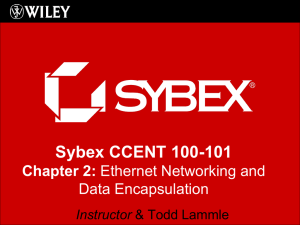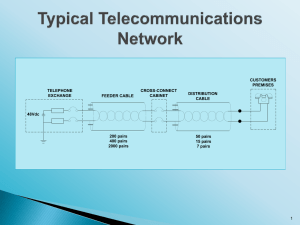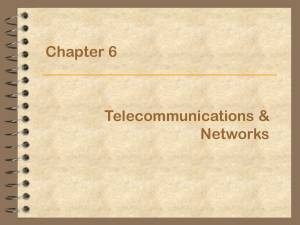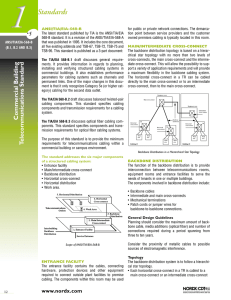Cabling - Wirewerks
advertisement
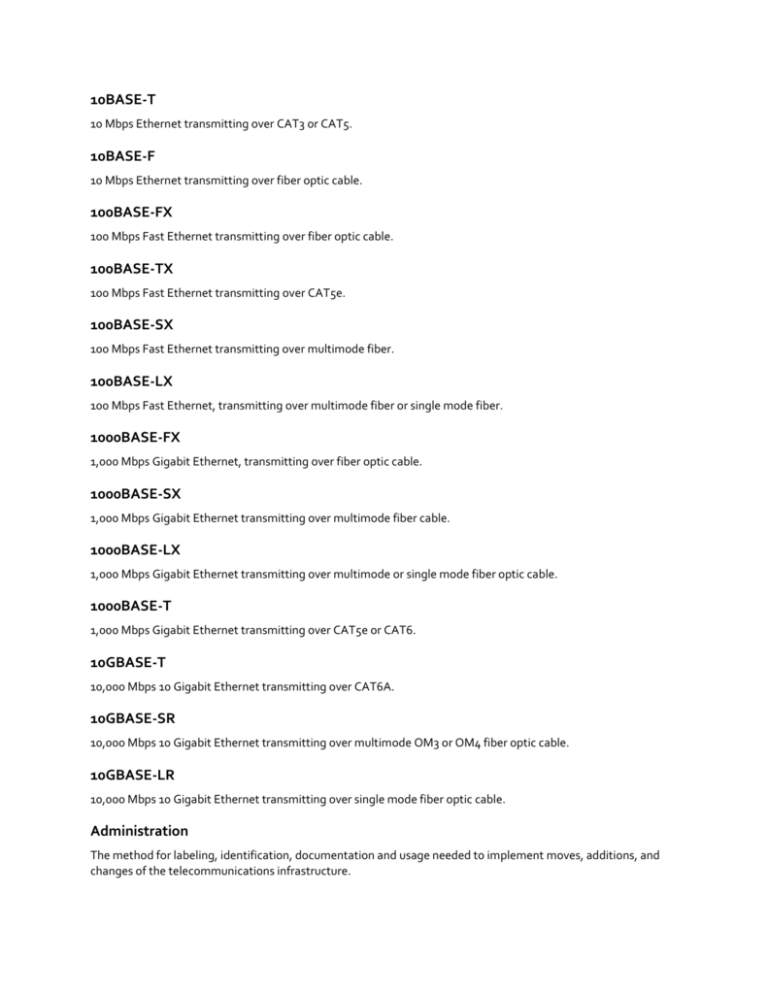
10BASE-T 10 Mbps Ethernet transmitting over CAT3 or CAT5. 10BASE-F 10 Mbps Ethernet transmitting over fiber optic cable. 100BASE-FX 100 Mbps Fast Ethernet transmitting over fiber optic cable. 100BASE-TX 100 Mbps Fast Ethernet transmitting over CAT5e. 100BASE-SX 100 Mbps Fast Ethernet transmitting over multimode fiber. 100BASE-LX 100 Mbps Fast Ethernet, transmitting over multimode fiber or single mode fiber. 1000BASE-FX 1,000 Mbps Gigabit Ethernet, transmitting over fiber optic cable. 1000BASE-SX 1,000 Mbps Gigabit Ethernet transmitting over multimode fiber cable. 1000BASE-LX 1,000 Mbps Gigabit Ethernet transmitting over multimode or single mode fiber optic cable. 1000BASE-T 1,000 Mbps Gigabit Ethernet transmitting over CAT5e or CAT6. 10GBASE-T 10,000 Mbps 10 Gigabit Ethernet transmitting over CAT6A. 10GBASE-SR 10,000 Mbps 10 Gigabit Ethernet transmitting over multimode OM3 or OM4 fiber optic cable. 10GBASE-LR 10,000 Mbps 10 Gigabit Ethernet transmitting over single mode fiber optic cable. Administration The method for labeling, identification, documentation and usage needed to implement moves, additions, and changes of the telecommunications infrastructure. Backbone A facility (e.g., pathways, cable or conductors) between telecommunications rooms, or floor distribution terminals, the entrance facilities, and the equipment rooms within and between buildings. Bundled Cable An assembly of 2 or more cables continuously bound together to form a single unit. Cabinet (telecommunications) An enclosure with hinged cover used for terminating telecommunications cables, wiring, and connection devices. Cable Management Physical structures attached to and/or within cabinets and racks to provide horizontal and vertical pathways for guiding and managing cabling infrastructure. Cable Rack Hardware designed and manufactured for horizontal pathway distribution pf cable inside the main distribution frame, telecommunication room. Cable Run A length of installed media which may include other components along its path. Cabling A combination of all cables, jumpers, cords, and connecting hardware. Channel The end-to-end transmission path between two points at which application-specific equipment is connected. Computer Room An architectural space which the primary function is to accommodate data processing equipment. Conduit (1) A raceway of circular cross sections. (2) A structure containing one or more ducts. Connecting Hardware A device providing mechanical cable terminations. Connectivity Patch panels, cabling, connectors, and cable management used to create and maintain electrical and optical circuits. Consolidation Point A location for interconnection between horizontal cables extending from building pathways and horizontal cables extending into furniture pathways. Cross-connect A facility enabling the termination of cable elements and their interconnection or cross connection. Data Center A building or portion of a building with the primary function to house a computer room and its support area. Demarcation Point A point where the operational control or ownership changes between carrier equipment and customer premises equipment. Entrance Facility An entrance to a building for both public and private network service cables (including wireless), including the entrance point of the building and continuing to the entrance room or space. Entrance Point The point of emergence for telecommunications cabling through an exterior wall, a floor, or from a conduit. Entrance Room or Space A space in which the joining of inter or intra building telecommunications backbone facilities takes place. Equipment Cable; Cord A cable or cable assembly used to connect telecommunications equipment to horizontal or backbone cabling. Equipment Distribution Area The computer room space occupied by equipment racks or cabinets. Equipment Room An environmentally controlled centralized space for telecommunications and data processing equipment with supporting communications connectivity infrastructure. Horizontal Cabling 1)The cabling between and including the telecommunications outlet/connector and the horizontal cross-connect. 2)The cabling between and including the building automation system outlet or the first mechanical termination of the horizontal connection point and the horizontal cross-connect. Horizontal Cross-connect A cross-connect of horizontal cabling to other cabling. Horizontal Distribution Area A space in the computer room where a horizontal cross-connect is located, and may include LAN switches, SAN switches, and keyboard/video/mouse (KVM) switches for the end equipment located in the equipment distribution area. Infrastructure (telecommunications) A collection of those telecommunications components, excluding equipment, that together provides the basic support for the distribution of all information within a building or campus. Interconnection A connection scheme that employs connecting hardware for the direct connection of a cable to another cable without a patch cord or jumper. Intermediate Cross-connect A cross-connect between first level and second level backbone cabling. Also referred to as the horizontal crossconnect. Jumper An assembly of twisted pairs without connectors, use to join telecommunications circuits/links at the crossconnect. Link A transmission path between two points, not including terminal equipment, work area cables, and equipment cables. Main Cross-connect A cross-connect for first level backbone cables, entrance cables, and equipment cables. Main Distribution Area The space in a computer room where the main cross-connect is located. Media (telecommunications) Wire, cable, or conductors used for telecommunications. Mission Critical Any operation, activity, process, equipment, or facility that is essential to continuous operation for reason of business continuity, personnel safety, security, or emergency management. Modular Jack/Connector A female telecommunications connector that may be keyed or unkeyed and may have 6 or 8 contact positions. Open Office A floor space division provided by furniture, moveable partitions, or other means instead of by building walls. Outlet Box (telecommunications) A housing used to hold telecommunications outlets/connectors. Outlets/connectors The fixed connector in an equipment outlet. Patch Cord A length of cable with a plug on one or both ends. Patch Panel A connecting hardware system that facilitates cabling termination and cabling administration using patch cords. Pathway A facility for the placement of telecommunications cable. Permanent Link A test configuration for a link excluding test cords and patch cords. Plenum A compartment or chamber that forms part of the air distribution system. Redundancy Providing secondary components that either become instantly operational or are continuously operational so that the failure of a primary component will not results in a mission failure. Riser Cable Communications cable that is used to implement backbones located on the same or different floor. SAN Storage Area Network (SAN) is a high-speed network of shared storage devices. Star Topology A topology in which telecommunications cables are distributed from a central point. Telecommunications Any transmission, emission, and reception of signs, signals, writings, images, and sounds, that is information of any nature by cable, radio optical, or other electromagnetic systems. Termination The physical connection of a conductor to a connecting hardware. Zone Distribution Area A space in a computer room where a zone outlet or a consolidation point is located.



